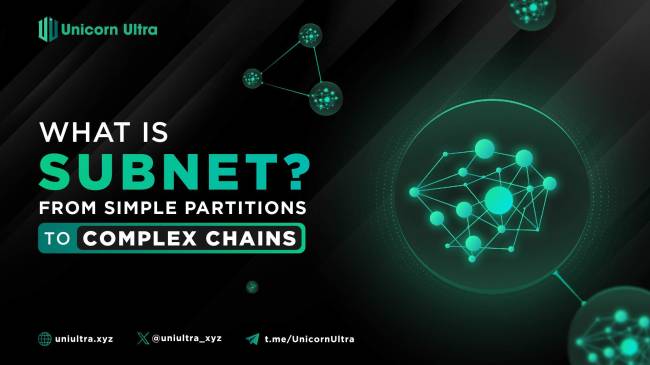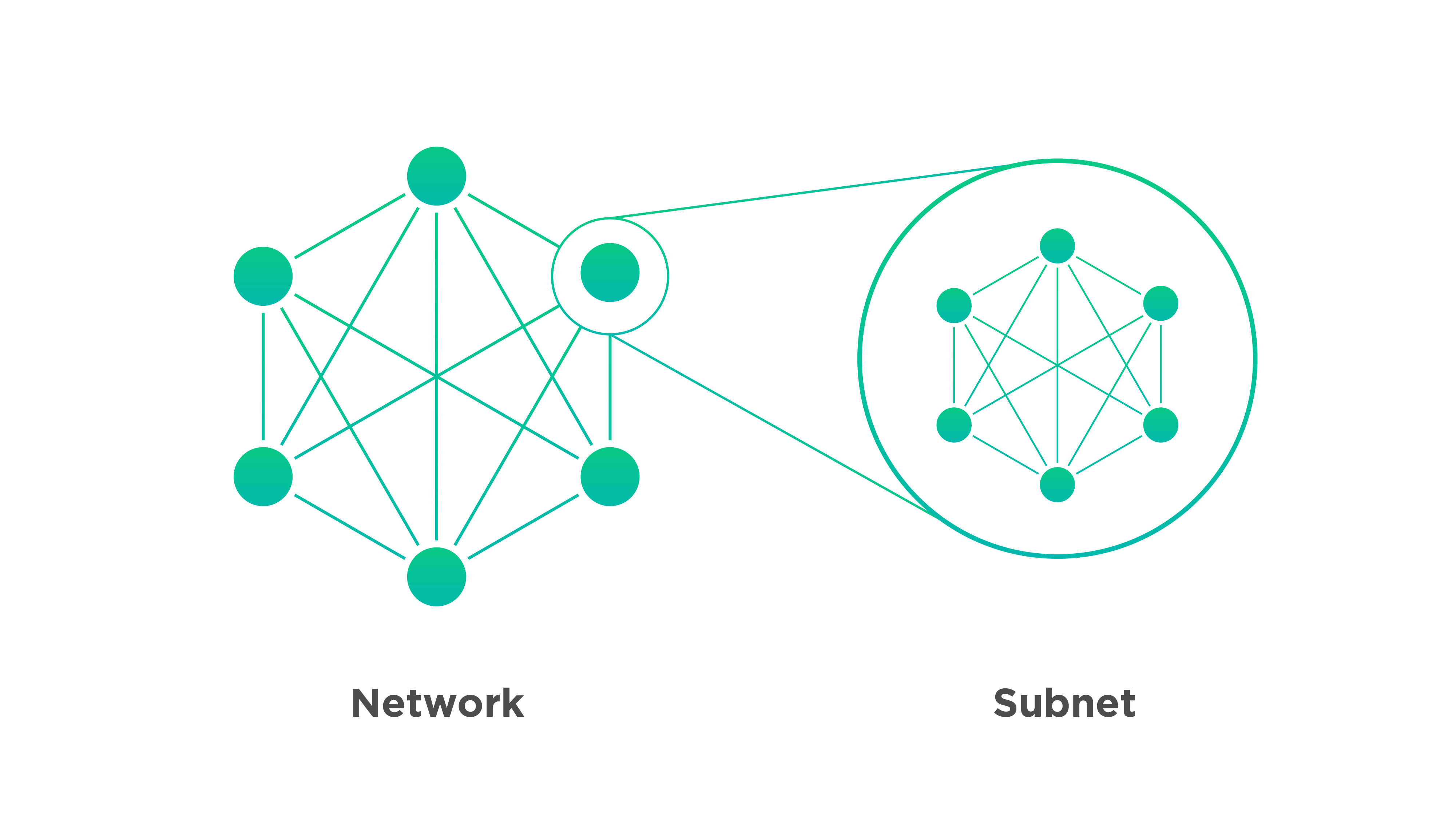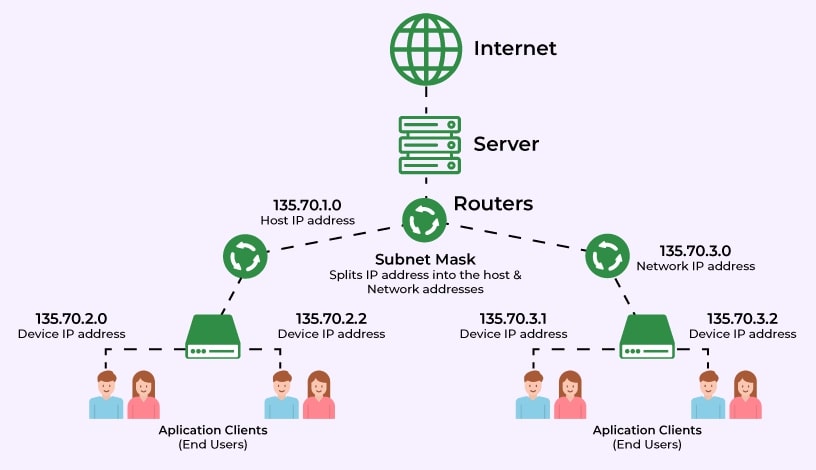
However, as technology has advanced, the applications of subnetting have expanded beyond the confines of traditional network management. In the modern era, one of the most compelling and innovative applications of subnetting is found in the realm of blockchain technology. Blockchain, a system of decentralized and distributed digital ledgers, faces unique challenges in scalability and security. Subnetting, with its ability to segment and manage network traffic efficiently, offers a promising solution to these challenges.
In this article, we will delve deeper into subnet as a concept, learning how its usage has transitioned from originally network routing in the early days of the Internet, to scaling solution for blockchain technologies in the modernized world.
What is subnet?

A subnet, or subnetwork, is a network within a network.
Subnetting emerged from the need to optimize network performance and manage IP addresses more effectively. In the early days of networking, managing a whole network as a single entity was increasingly impractical due to the growing size and complexity of networks. Subnetting offered a solution by dividing a large network into smaller, easier-to-manage segments.
Specifically, every device that connects to the Internet is assigned a unique IP (Internet Protocol) address, enabling data sent over the Internet to reach the right device out of the billions of devices connected to the Internet. While computers read IP addresses as binary code (a series of 1s and 0s), IP addresses are usually written as a series of alphanumeric characters.
For example, IPv4 addresses are presented in the form of four decimal numbers separated by periods, like 203.0.113.112.
Every IP address has two parts. The first part indicates which network the address belongs to. The second part specifies the device within that network. However, the length of the "first part" changes depending on the network's class.
Networks are categorized into different classes, labeled A through E. Class A networks can connect millions of devices. Class B networks and Class C networks are progressively smaller in size. (Class D and Class E networks are not commonly used.)
Let's break down how these classes affect IP address construction, using the above IPv4 address “203.0.113.112” as an example:
- Class A network: Everything before the first period indicates the network, and everything after it specifies the device within that network. In this instance, the network is indicated by "203" and the device by "0.113.112.
- Class B network: Everything before the second period indicates the network. In this instance, "203.0" indicates the network and "113.112" indicates the device within that network.
- Class C network: For Class C networks, everything before the third period indicates the network. In this instance, "203.0.113" indicates the Class C network, and "112" indicates the device.
As the previous example illustrates, the way IP addresses are constructed makes it relatively simple for Internet routers to find the right network to route data into. However, in a Class A network (for instance), there could be millions of connected devices, and it could take some time for the data to find the right device. This is why subnetting comes in handy: subnetting narrows down the IP address to usage within a range of devices. Without applying subnets, finding an IP address among billions of devices is virtually impossible.

How is subnet applied in blockchain?
Blockchain technology, renowned for its decentralized nature, introduced new networking paradigms. Unlike traditional centralized networks, blockchain networks distribute data across a vast array of nodes (computers). This decentralization offers benefits like transparency and security but also brings unique challenges in managing network traffic and ensuring efficient data processing.
Subnets offer a compelling solution to the scalability and performance challenges faced by blockchain networks. By dividing a blockchain network into subnets, each segment can process transactions and manage data independently. This division not only accelerates transaction processing but also enables parallel data handling, significantly enhancing network throughput.
There are numerous ways to apply the subnet concept into blockchain. For instance, Ethereum's proposed sharding mechanism is a type of subnetting. Sharding divides the network into smaller, more manageable pieces (shards), with each shard processing a fraction of the network's transactions. This division dramatically increases the number of transactions the network can process simultaneously.
Another application of subnet in blockchain is U2U Subnet. Built atop of U2U Chain, U2U Subnets are separate subnetworks, each connected to another, and all is connected back to U2U Chain, ensuring omnipresent interoperability yet still highly secure. Each U2U Subnet is designed distinctively to match a specific demand; for example, there is a Subnet for DPN (Decentralized Private Network), a Subnet for Decentralized ID, a Subnet for Data Storage, a Subnet for Matching Engine... By allocating each Subnet a discrete application, U2U Subnets can be especially optimized for that task to reach maximum performance, making them suitable for decentralized services whereas most existing blockchains are general-purpose, which are inefficient and easily overloaded.
Advantages of subnet in blockchain
With its various use cases, subnet brings a wide range of benefits to the realm of blockchain technologies. Here we mention some of the biggest advantages of subnet in the context of blockchain.
Enhancing Efficiency and Scalability
Subnets address one of the most pressing issues in blockchain technology: scalability. By facilitating parallel processing of transactions, subnets allow blockchain networks to handle a higher volume of transactions without a proportional increase in computational load. This capability is crucial for blockchain's adoption in areas requiring high transaction throughput, like financial services or supply chain management.
Fortifying Security
Subnetting also enhances the security of blockchain networks. By isolating specific sections of the network, subnets can contain and mitigate the impact of any security breaches. This isolation is vital in a decentralized system where a single vulnerability can have far-reaching consequences.
Tailored Solutions through Subnets
Perhaps the most significant advantage of subnets in blockchain is their ability to support customized solutions. Different blockchain applications have diverse requirements; subnets enable the creation of tailored environments that meet these specific needs, offering a more flexible and adaptable approach to blockchain network design.
Conclusion
In essence, subnets are not just a feature of network architecture but a driving force in the advancement of blockchain technology. As blockchain technology continues to evolve, subnets stand at the forefront of this evolution, essential in shaping its future trajectory. They offer a path towards more efficient, secure, and adaptable blockchain networks, addressing key challenges like scalability and security.
The ongoing development of subnet technologies promises to unlock new potentials in blockchain applications, paving the way for more sophisticated and versatile decentralized systems. One such example - our U2U Subnet, redefines blockchain scalability and efficiency. Its rapid communication, minimal data storage, and application-specific prowess set new standards, making decentralized technologies a formidable match for centralized systems.





.png)
